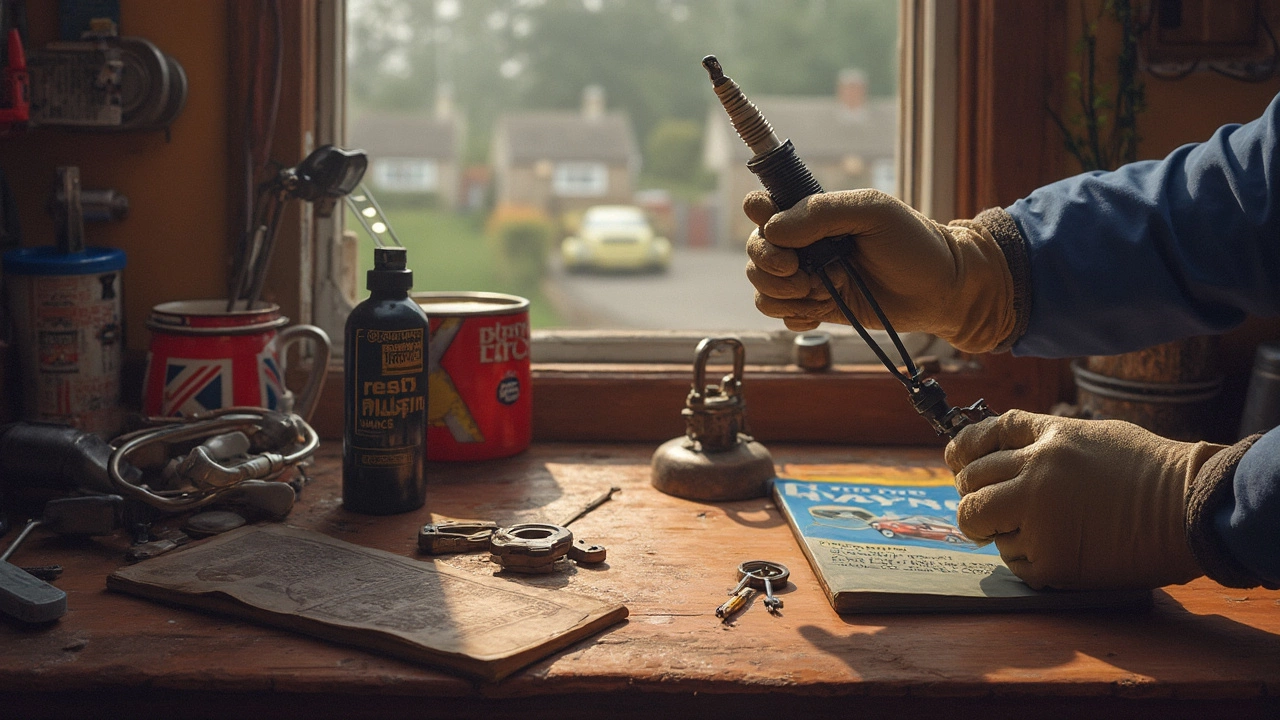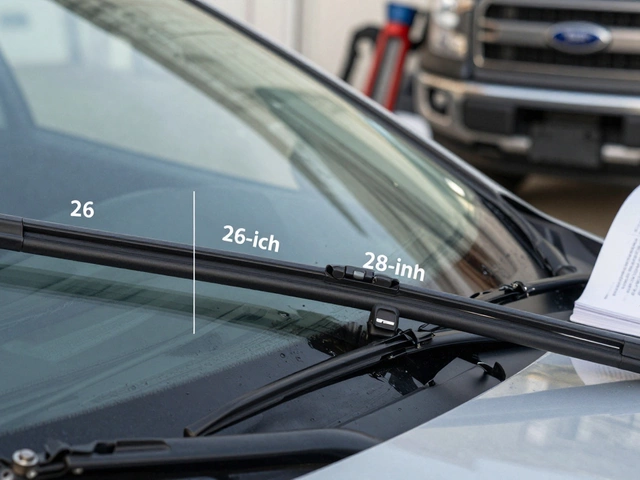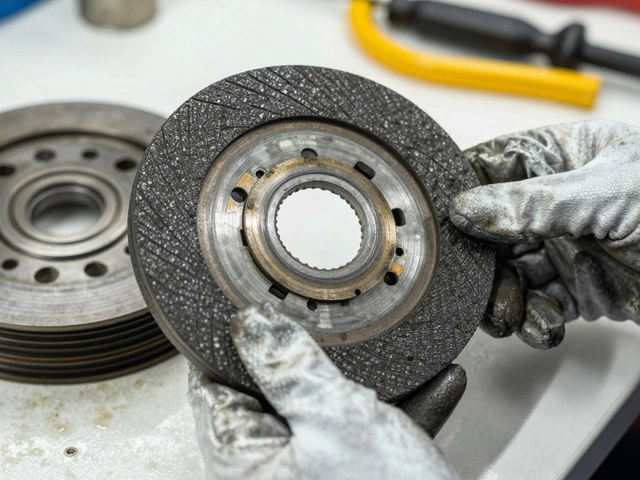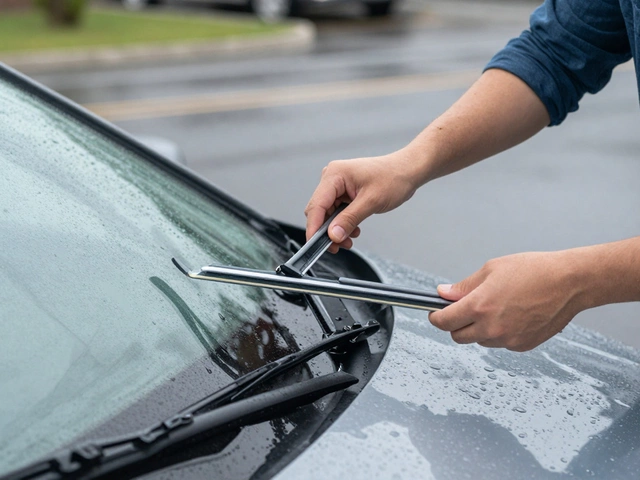Ever felt your car shudder at a stoplight or hesitate when you hit the gas? One sneaky culprit: dirty spark plugs. These tiny parts fire your engine to life, but grime and build-up slow them down fast. If you skip cleaning or wait too long, you end up with rough idling, weak power, or even trouble starting on a chilly morning.
Most folks think of spark plugs as "install and forget" parts, but that's a quick route to engine headaches. The truth is, spark plugs get dirty way before they actually wear out. Cleaning them not only keeps your ride running smoother, but also saves you money on gas and repairs down the line. If you only pop the hood when something sounds wrong, you might be missing out on easy fixes that keep your engine healthy for years.
- Why Spark Plug Condition Matters
- How to Spot Dirty or Failing Spark Plugs
- Typical Cleaning Schedules
- DIY Tips for Cleaning Spark Plugs
- When It’s Time to Replace Instead of Clean
Why Spark Plug Condition Matters
If you care about how your engine runs, you can't ignore your spark plugs. When they're clean and working right, you get smooth starts, reliable performance, and the best fuel efficiency your car can offer. But let them get dirty, and things go downhill quick—misfires, sluggish acceleration, and even lousy mileage start showing up.
Here’s the deal: spark plugs set off the bang inside your engine that makes your car move. If they’re dirty or fouled up, they mess with the timing and strength of the spark. According to the experts at NGK Spark Plugs, "A single misfiring spark plug can decrease fuel efficiency by as much as 30%."
"The smallest amount of dirt or carbon build-up on a spark plug can change the voltage needed for a proper spark and lead to hard starts and poor engine performance." — NGK Spark Plugs (2024 Service Bulletin)
Even something as simple as oil or fuel deposits will force your engine to work harder. That means wasted gas, rough rides, and more wear and tear on parts that should last way longer.
Here’s how spark plug condition stacks up:
| Plug Condition | Impact on Engine | Fuel Efficiency |
|---|---|---|
| Clean/Good | Good power, easy starts | Optimal |
| Dirty/Carbon-fouled | Hesitation, misfires | Down up to 30% |
| Oil-fouled | Hard starting, rough idle | Usually decreased |
| Worn Out | Misses, stalling, engine damage risk | Poor |
So, keeping an eye on the spark plugs isn't just for car fanatics—it's basic upkeep that keeps you saving money and avoiding headaches. The easiest way to dodge expensive repairs is just to check and clean them before problems pile up.
How to Spot Dirty or Failing Spark Plugs
Your car won't just wave a flag when the spark plugs get grimy, but there are a few dead giveaways to watch for. The engine might feel rough when you start it, or you’ll notice it takes longer to turn over. If your car starts to feel jerky when you accelerate, or the engine stutters at idle, dirty spark plugs could be the cause.
Pay attention to the way your engine sounds and feels. Problems like a sudden drop in fuel efficiency or engine misfires often trace back to spark plug issues. The check engine light can also pop on, especially if misfires get bad.
If you’re more hands-on, pop the spark plugs out for a look. Here’s what to check for:
- spark plugs with black, sooty tips – this means carbon build-up, usually from a rich fuel mix or lots of stop-and-go driving.
- Oily residue – oil on the spark plug tip usually points to worn-out seals or engine wear.
- White, chalky deposits – these often mean your engine’s been running hot or there’s a coolant leak.
- A gap that’s way bigger or smaller than it should be – this throws off the spark, so check your owner’s manual for the right size.
One or two of these signs on a single plug might be a fluke, but if most of your plugs are dirty, it’s time for a cleaning session or maybe a tune-up. Always compare all your spark plugs—seeing patterns tells you more than just looking at one plug in isolation. Catching these signs early can save you a lot of gas money and even prevent bigger repairs.

Typical Cleaning Schedules
If you're not sure when to get your hands dirty, here's the real deal: most car makers recommend checking your spark plugs every 30,000 miles or so. That doesn’t always mean you have to clean or swap them out every single time. But if you’re rolling lots of city miles (think stop-and-go traffic), or if your engine spends time idling, you might want to do a quick check as early as 15,000 to 20,000 miles.
Modern spark plugs made with platinum or iridium can handle more miles before showing problems. Older copper plugs sometimes need a look even earlier, especially in cars that burn a little oil or run rich. If you’re running a performance engine or pushing your car hard, dirt and deposits build up quicker. Here’s a simple look at when to check and clean based on plug type and driving style:
| Plug Type | Normal Driving | Heavy/City Driving |
|---|---|---|
| Copper | Every 15,000-20,000 miles | Every 10,000-15,000 miles |
| Platinum/Iridium | Every 30,000-40,000 miles | Every 20,000-30,000 miles |
Don’t rely on mileage alone. If the car feels rough, takes a while to start, or your gas mileage dips, spark plugs could be the culprit even if you haven’t hit the schedule yet. Set a reminder or write the miles on a piece of tape under your hood. Checking early is always better than getting stranded or spending more on repairs later.
Lastly, keep in mind that motorcycles, lawn mowers, and some older vehicles can gum up their plugs a lot faster—sometimes every season, depending on use. For these, peek at the plugs when you do a basic tune-up or after a rough run.
DIY Tips for Cleaning Spark Plugs
Want to save a few bucks and keep your car from sputtering along? Cleaning your own spark plugs isn’t rocket science, and you don’t need pro tools or a big budget. But there are some basics to nail so you don’t end up causing more harm than good.
The first thing you need is the right gear. Grab a socket wrench with a spark plug socket (you'll want the rubber insert to keep plugs safe), a wire brush, some carburetor cleaner, and a clean rag. If you have compressed air, that’s a bonus for blasting away dirt fast.
- Remove Spark Plugs Carefully: Make sure your engine is cool. Unplug the spark plug wires by pulling from the boot, not the wire—no one likes a broken wire.
- Inspect Before Cleaning: Look for obvious cracks, heavy oil, or burned tips. You might need new plugs if they look trashed.
- Gently Clean the Tips: Spray carburetor cleaner on the insulator and electrode. Use your wire brush to scrub away carbon build-up. Don’t gouge the metal—gentle but thorough does the trick.
- Dry Out: Blow out the plug with compressed air, or use a lint-free rag. Moisture left behind can lead to weak sparks or misfires.
- Check the Gap: Use a gap tool to make sure your electrode gap matches your car’s spec, which you’ll find in the owner’s manual. Bad gaps mean bad firing.
- Reinstall: Put the plug back and hand-tighten before using the wrench, so you don’t strip the threads. Connect the plug wire, making sure it snaps on tight.
Don’t take my word for it, though. The Car Care Council always says,
"Proper spark plug maintenance—not just replacement—can boost fuel mileage by as much as 30%."
Let’s look at how grime builds up so you know what you’re fighting:
| Type of Buildup | What it Means | Cleaning Needed? |
|---|---|---|
| Black Soot (Carbon) | Rich fuel mix or short trips | Yes |
| Oily Deposits | Worn piston rings or valve guides | No, replace plug |
| White Ash | Fuel additives or oil leaks | Maybe, but check engine health |
| Normal Light Tan | Healthy engine | No, just quick wipe |
One last tip: Wear gloves and eye protection. Chemicals and mud don’t care about your Saturday plans. And don’t forget to clean one plug at a time so you don’t swap the wires around and end up with a misfiring engine. This job’s pretty straightforward if you go slow and pay attention—no mechanic’s license required.

When It’s Time to Replace Instead of Clean
Cleaning spark plugs can add miles to their life, but eventually, there’s no fixing what’s worn out. So how do you know when to stop scrubbing and just swap them out? Here’s the deal: even if you’re on top of regular cleaning, every spark plug has an expiration date. Most modern plugs last anywhere from 30,000 to 100,000 miles, depending on what they’re made of—copper, platinum, or iridium.
But mileage isn’t the only sign. Look for issues like cracked porcelain, broken electrodes, or burned tips. If any of this pops up, cleaning won't help. Check your vehicle’s manual too. Some engines are fussy about plug condition and need new ones, not just clean ones, for top-notch performance.
- Spark plugs with deep carbon tracking (black lines down the insulator) are done for. That’s a surefire sign of leakage and misfiring that a wire brush can’t fix.
- If the plug’s electrode is rounded off or worn thin, it can’t spark strong no matter how clean you get it.
- If there’s heavy oil or ash buildup that won’t come off with standard cleaning, swap it out.
- Bad engine misfires after plug cleaning? Don’t waste time. Get new plugs—once plugs break down, they don’t come back to life.
Here’s a quick cheat sheet so you don’t have to guess:
| Condition | Clean or Replace? |
|---|---|
| Light carbon/soot buildup | Clean |
| Oil-soaked or fuel-fouled | Replace |
| Cracked porcelain or insulator | Replace |
| Burned or melted electrode | Replace |
| Minor tip wear | Clean |
| Severe tip wear/worn-down electrode | Replace |
One more pro tip: even if your plugs look "okay," most techs recommend swapping them as a set. Mixing old and new plugs can cause uneven firing, which isn’t great for your engine. Keep to a schedule and watch for those signs—your engine and your wallet will thank you.








